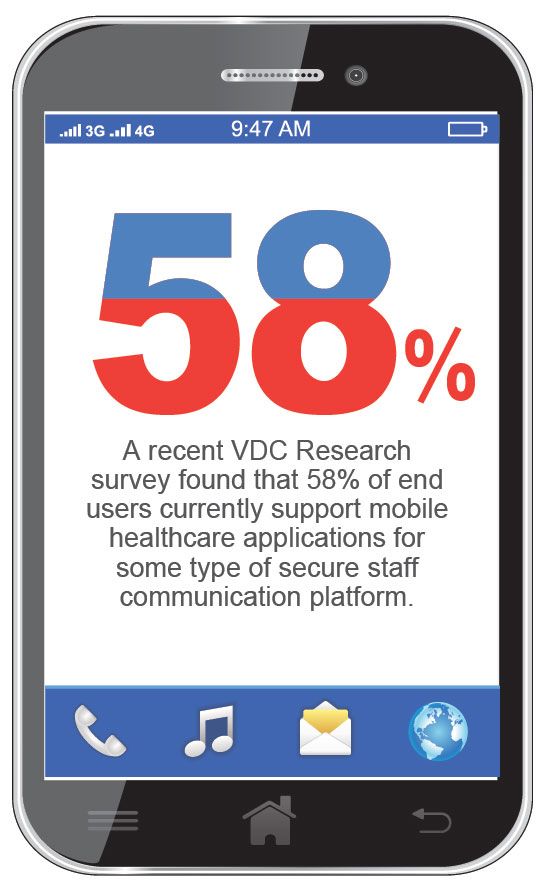Enterprise Mobility & the Connected Worker Blog
Secure Messaging 2.0: Evolving Beyond Traditional Communications
 By: Cameron Roche, Research Analyst and Allyson Koval, Research Associate
By: Cameron Roche, Research Analyst and Allyson Koval, Research Associate
Many forward-thinking hospitals and clinics are upgrading expensive legacy pager systems and adopting more efficient and effective communications platforms. Replacing these pagers are secure messaging applications coupled with a mobile device (handheld/smartphone, tablet, or wearable). In fact, a recent VDC Research healthcare survey found that 58% of end-users currently support mobile healthcare applications for some type of secure staff communication platform. Vendors in the healthcare community have been marketing now-traditional secure messaging systems for the past few years, but this raises the question of how vendors will continue to differentiate themselves in an increasingly competitive ecosystem. The next generation of secure messaging applications will need to move beyond traditional HIPPA compliant text and image messaging to provide distinctive capabilities. As the era of secure messaging 2.0 draws closer, vendors will begin to include enhanced applications, unique services, and cross-platform capabilities. This post highlights how three industry class vendors are approaching differentiation in their next generation solutions.
TigerText, founded in 2010, offers a traditional HIPPA compliant messaging platform, but distinguishes itself through its HealthBot and Nuance Dragon Medical One solutions. Announced in May, HealthBot is an encrypted messaging application that can be embedded into a web-page or mobile application. Healthbot leverages the TigerConnect secure messaging platform to create structured conversations utilizing a natural language processing system. Through a chat window, patients can interact with HealthBot to schedule appointments, research medical information, or receive medication reminders. Furthermore, the Nuance Dragon Medical One enables developers to enhance secure messaging applications through its cloud-based speech recognition platform. Through various speech tools, the platform accurately translates a care provider’s voice into a clinical message; ultimately resulting in more time spent interacting with patients. TigerText’s solutions are noteworthy as they engage patients at multiple points in healthcare process; Healthbot engages patients when they are away from the doctor, while Nuance Dragon enables physicians to engage with patients directly.
Leveraging mobile technologies through a different approach, Voalte is piloting a program that focuses on supplementing their secure messaging platform through partnering with outside services. In the second half of 2015, Voalte announced an innovative initiative with Uber to better manage patient transportation in Florida’s Sarasota Memorial Health Care System. The new application integrates with Uber’s internet-enabled platform to give a small pilot group of patients the option to pre-arrange rides for physician visits, lab works, rehabilitation, or other post-treatment appointments. When patients miss follow-up appointments, they run a higher risk of emergency room re-admittance. As such, this new application is designed to help patients keep important appointments and detect possible problems earlier. Older patients are especially known for missing follow-up appointments and typically lag behind first-adopters with new technologies. Testing this pilot program in Florida, which is well-known for its retired population, may result in some biased behaviors; however, if Voalte and Uber are successful, then likelihood of market-wide success should be much higher. With the ultimate goal of implementing the solution at hospitals across the country, the two companies will spend the next year refining, testing, and expanding this program.
Blackberry is also working with outside vendors to further its position in the secure messaging field, but has also made key industry acquisitions. In September 2015, Blackberry acquired Good Technology, a mobile security provider that secures apps and data on enterprise mobile devices. The addition of Good Technology will enable Blackberry to create an enterprise mobility solution offering cross-platform secure messaging for IoT, medical devices, and wearables. As wearables continue to gain traction in the healthcare industry, Blackberry looks to provide additional capabilities and other advanced security features purposely designed for such devices. Building on its secure solution portfolio, Blackberry recently partnered with Sharecare, makers of a leading digital health and wellness engagement platform. Sharecare collects health data points from users and compiles that information to create profiles where users can access and connect with health resources. Sharecare will be the first company to integrate BBM messaging and VOIP infrastructure capabilities into its native application. The partnership is mutually beneficial as Sharecare will provide customers with a safe, central location to store, manage, and update health information.
In order to stand out in the next generation of secure messaging solutions, vendors must continue to offer unique differentiators like the three instances discussed above. While these vendors are by no means the only ones driving this technology forward, they demonstrate how the ecosystem needs to work together to create solutions which will enable hospitals to more effectively engage with patients and provide more efficient communication between healthcare team members. Look for vendors who think outside the box, such as TigerText, Voalte, and BlackBerry, to lead the ecosystem into the era of secure messaging 2.0. For more detailed information, be sure to review Mobilizing Healthcare: From Providers to Patients- set to be released in late September.
View the 2017 Enterprise Mobility & Connected Devices Research Outline to learn more.